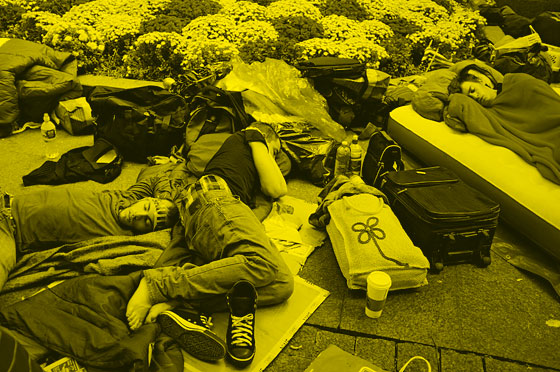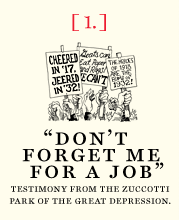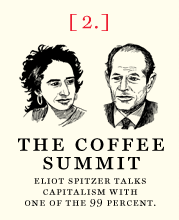 |
The Bonus Army veterans stage a mass vigil on the lawn of the U.S. Capitol in 1932.
(Photo: MPI/Getty Images) |
During the death throes of Herbert Hoover’s presidency in June 1932, desperate bands of men traveled to Washington and set up camp within view of the Capitol. The first contingent journeyed all the way from Portland, Oregon, but others soon converged from all over—alone, in groups, with families—until their main Hooverville on the Anacostia River’s fetid mudflats swelled to a population as high as 20,000. The men, World War I veterans who could not find jobs, became known as the Bonus Army—for the modest government bonus they were owed for their service. Under a law passed in 1924, they had been awarded roughly $1,000 each, to be collected in 1945 or at death, whichever came first. But they didn’t want to wait any longer for their pre–New Deal entitlement—especially given that Congress had bailed out big business with the creation of a Reconstruction Finance Corporation earlier in its session. Father Charles Coughlin, the populist “Radio Priest” who became a phenomenon for
railing against “greedy bankers and financiers,” framed Washington’s double standard this way: “If the government can pay $2 billion to the bankers and the railroads, why cannot it pay the $2 billion to the soldiers?”
The echoes of our own Great Recession do not end there. Both parties were alarmed by this motley assemblage and its political rallies; the Secret Service infiltrated its ranks to root out radicals. But a good Communist was hard to find. The men were mostly middle-class, patriotic Americans. They kept their improvised hovels clean and maintained small gardens. Even so, good behavior by the Bonus Army did not prevent the U.S. Army’s hotheaded chief of staff, General Douglas MacArthur, from summoning an overwhelming force to evict it from Pennsylvania Avenue late that July. After
assaulting the veterans and thousands of onlookers with tear gas, MacArthur’s troops crossed the bridge and burned down the encampment. The general had acted against Hoover’s wishes, but the president expressed satisfaction afterward that the government had dispatched “a mob”—albeit at the cost of killing two of the demonstrators. The public had another take. When graphic newsreels of the riotous mêlée fanned out to the nation’s movie theaters, audiences booed MacArthur and his troops, not the men down on their luck. Even the mining heiress Evalyn Walsh McLean, the owner of the Hope diamond and wife of the proprietor of the Washington
Post, professed solidarity with the “mob” that had occupied the nation’s capital.
The Great Depression was then nearly three years old, with FDR still in the wings and some of the worst deprivation and unrest yet to come. Three years after our own crash, we do not have the benefit of historical omniscience to know where 2011 is on the time line of America’s deepest bout of economic distress since that era. (The White House, you may recall,
rolled out “recovery summer” sixteen months ago.) We don’t know if our current president will end up being viewed more like Hoover or FDR. We don’t know whether Occupy Wall Street and its proliferating satellites will spiral into larger and more violent confrontations, disperse in cold weather, prove a footnote to our narrative, or be the seeds of something big.
What’s as intriguing as Occupy Wall Street itself is that once again our Establishment, left, right, and center, did not see the wave coming or understand what it meant as it broke. Maybe it’s just human nature and the power of denial, or maybe it’s a stubborn strain of all-American optimism, but at each aftershock since the fall of Lehman Brothers, those at the top have preferred not to see what they didn’t want to see. And so for the first three weeks, the protests were alternately ignored, patronized, dismissed, and insulted by politicians and the mainstream news media as a neo-Woodstock for wannabe collegiate rebels without a cause—and not just in Fox-land. CNN’s new prime-time hopeful,
Erin Burnett, ridiculed the protesters as bongo-playing know-nothings; a dispatch in
The New Republic called them “an unfocused rabble of ragtag discontents.” Those who did express sympathy for Occupy Wall Street tended to pat it on the head before going on to fault it for being leaderless, disorganized, and inchoate in its agenda.
Despite such dismissals, the movement, abetted by
made-for-YouTube confrontations with police, started to connect with the mass public much as the Bonus Army did with a newsreel audience. The week after a
Wall Street Journal editorial claimed that “no one seems to care very much” about the “collection of ne’er-do-wells” congregating in Zuccotti Park,
the paper released its own poll, in collaboration with NBC News, finding that 37 percent of Americans supported the protesters, 25 percent had no opinion, and just 18 percent opposed them. The approval numbers for Occupy Wall Street published in
Time and
Reuters were even higher—hitting 54 percent in
Time. Apparently some of those dopey kids, staggering under student loans and bereft of job prospects, have lots of parents and friends of all ages who understand exactly what they’re talking about.
 |
Occupy Wall Street demonstrators asleep in Zuccotti Park.
(Photo: Spencer Platt/Getty Images) |
Coverage increased and politicians ran for cover. Mayor Bloomberg, who had initially (and preposterously) portrayed the occupiers as
a threat to the financial industry’s lower-income service workers, gingerly observed that
some unspecified “people” are “very frustrated.” Though the Treasury secretary,
Timothy Geithner, replied with a flat “no” when asked if he had any sympathy for Occupy Wall Street,
Barack Obama publicly acknowledged the demonstrators’ “broad-based frustration about how our financial system works.” (If Bloomberg and Obama are both using “frustration,” you can be certain it is a focus-group-tested trope chosen not to frighten the presumed sensibilities of independents.) Mitt Romney, who had
first called the protests “dangerous,” executed another of his patented flip-flops to assert that he, too, identifies with America’s 99 percent, not the top one percent where he’s always dwelled.
“Boy, I understand how these people feel,” he said. (Boy, do “these people” not believe him.) Even Eric Cantor, who’d
described the protesters as “mobs,” started talking about—what else?—
“frustration.”
These efforts to domesticate and contain the protests are unlikely to succeed. It is not frustration that’s roiling America but anger, the anger of a full-fledged class war. Try as polite company keeps trying to ignore it, that war has been building in this country and abroad for much of this decade and has been waged in earnest in America since the fall of 2008. But the crisp agenda demanded of Occupy Wall Street will not be forthcoming. The inchoateness of our particular class war is central to its meaning. America is not
Tahrir Square or the
riot-scarred precincts of North London, where everyone knows at birth who is in which class and why. We pride ourselves on being a “classless” democracy. We abhor ideology. When Americans left and right, young and old, express anger at an overclass, they don’t necessarily agree about who’s on which side of that class divide. The often confusing fluidity of class definitions, especially in an America as polarized as ours is now, may make our homegrown class war more volatile, not less.
The tea-party right finds the hippie-scented movement in lower Manhattan repellent, but it and Occupy Wall Street are two sides of the same coin. “Take Back America,” the initial tea-party battle cry, would work for those in Zuccotti Park as well. The disagreement is about which America needs to be taken back, and from whom.
Provoked by Obama’s ascent, the right was ahead of the class-war curve, with Sarah Palin sounding the charge when
she stuck up for “the real America” against the elites during the 2008 campaign. The real America, as she defined it, was in small towns—“those who are running our factories and teaching our kids and growing our food.” In other words: It is the middle class (or at least its white precincts) that fell behind while the rich got richer. The
Über-class she and her angry followers would take to the guillotine, however, is not defined by its super-wealth. It is first and foremost exemplified by potentates in the federal government, especially the Ivy League cohort of Obama—closely followed by the usual right-wing populist bogeymen, the pointy-headed experts in fancy universities and the mainstream-media royalty with their “gotcha” questions.
Palin may now have abdicated her position on the barricades, not least because she succumbed to
the financial blandishments of the unreal America, but the zeal of her constituency has not faded a bit. The right’s angry class warriors constitute the vast majority of the GOP—that roughly three-quarters of the party that seems determined to resist Romney no matter what. A Harvard-educated former Massachusetts governor, especially one who embraced the social engineering of health-care reform, inspires class anger from his own party to the same degree that his private-sector record as a leveraged-buyout tycoon provokes class anger from Democrats.
But while Romney is a class enemy liberals and conservatives can unite against, perhaps nothing has revealed how much the class warriors of the right and left of our time have in common than the
national outpouring after Steve Jobs’s death. Indeed, the near-universal over-the-top emotional response—more commensurate with a saintly religious or civic leader, not a sometimes bullying captain of industry—brought Americans of all stripes together as few events have in recent memory.
Some on the right were baffled that the ostensible Marxists demonstrating in lower Manhattan would observe a moment of silence and assemble makeshift shrines for a top one-percenter like Jobs, whose expensive products were engineered for near-
instant obsolescence and produced by Chinese laborers in factories with
substandard health-and-safety records. For heaven’s sake, the guy
didn’t even join Warren Buffett and Bill Gates in their Giving Pledge. “There is perhaps no greater image of irony,” wrote
the conservative blogger Michelle Malkin, “than that of anti-capitalist, anti-corporate, anti-materialist extremists of the Occupy Wall Street movement paying tribute to Steve Jobs.”
Yet those demonstrators who celebrated Jobs were not necessarily hypocrites at all—and no more anti-capitalist than the Bonus Army of 1932. If you love your Mac and iPod, you can still despise CDOs and credit-default swaps. Jobs’s genius—in the words of Regis McKenna, a Silicon Valley marketing executive who worked with him early on—was his ability “to strip away the excess layers of business, design, and innovation until only the simple, elegant reality remained.” The supposed genius of modern Wall Street is the exact reverse, piling on excess layers of business and innovation on ever thinner and more exotic creations until simple reality is distorted and obscured. Those in Palin’s “real America” may not be agitated about the economic 99-vs.-one percent inequality brought about by the rise of the financial sector in the past three decades, but, like class warriors of the left, they know that “financial instruments” wreaked havoc on their 401(k)s, homes, and jobs. The bottom line remains that Wall Street’s opaque inventions led directly to TARP, the taxpayers’ bank bailout that achieved the seemingly impossible feat of unifying the left and right in rage against government—much as Jobs’s death achieved the equally surprising coup of unifying left and right in mourning a corporate god.
That bipartisan grief was arguably as much for the passing of a capitalist culture as for the man himself. Finance long ago supplanted visionary entrepreneurial careers like Jobs’s as the most desired calling among America’s top-tier university students, just as hedge-fund tycoons like
John Paulson and
Steve Cohen passed
Jobs on the Forbes 400 list. Americans sense that something incalculable has been lost in this transformation that cannot be measured in dollars and cents.
There’s no handier way to track just how much American capitalism has changed since Apple’s divine, mid-seventies birth in a garage than by following the corporate afterlife of the American icon most frequently invoked as Jobs’s antecedent in his obituaries, Thomas Alva Edison. Like Jobs, Edison wasn’t just a brilliant fount of technological breakthroughs but a businessman as well (albeit a less savvy one). He was the
official founder of General Electric—known as Edison General Electric at its inception in 1890, before Edison was strong-armed into an early merger. G.E. was created to maximize the profits of his many inventions and businesses, Apple style. And like Apple, the company flourished as an exemplar of American capitalism at its most creative and productive, even in a downtime. During the Great Depression, it produced
an astonishing array of Jobs-worthy innovations—the first commercial fluorescent lamp, the first waste “Disposall,” the first night baseball game, and the first television network. This was the job-creating, profit-making, America-empowering corporate behemoth, spewing out refrigerators and jet engines, that would ultimately
recruit Ronald Reagan as its television pitchman in the fifties.
But the G.E. born out of Edison’s genius and synergistic with Reagan’s brand of postwar jingoism is far from the G.E. of our time. Its once minor financial-services subsidiary, G.E. Capital, metastasized over the past 30 years in sync with the growth of the new Wall Street. In 1990, G.E. Capital accounted for just a quarter of G.E.’s overall profits, but by 2007, on the eve of the crash, it had gobbled up
55 percent of the bottom line. Its sophisticated gambling strategies, like those of the big banks it emulated, amounted to an ingenious get-rich-quick scheme for high-rollers until the bottom fell out, taking shareholders and employees, not to mention the country, down with it. G.E. Capital’s
dependence on short-term credit was so grave that it forced G.E. to cut back its dividend for the first time since the thirties and to turn to Buffett for a $3 billion emergency cash infusion in the dark days of October 2008.
The cheerleader for ratcheting up that risk at G.E. was the CEO, Jeffrey Immelt. These days he heads the president’s ineffectual
Council on Jobs and Competitiveness, despite his own corporation’s record of job-shedding in America and the revelation that G.E.
paid no American taxes in 2010 (on more than $14 billion in profits, including $5.1 billion in the U.S.). Immelt is a Republican, but that didn’t prevent Palin this fall from calling G.E. “
the poster child of corporate welfare and crony capitalism.” (Bill O’Reilly and Newt Gingrich joined this class-warfare chorus.) On this point, once again, there is no air between the right and Occupy Wall Street. And as both camps condemn Immelt, so they are also united in the conviction that the godfather of Obama’s economic team, Robert Rubin, is likewise a poster child for corporate welfare and crony capitalism. Rubin, whose useful cronies included his former protégés Geithner and Lawrence Summers,
encouraged reckless greed and risk at Citigroup during the bubble much as Immelt did at G.E. Capital, ultimately requiring the taxpayers’ rescue of TARP.
Politicians in either party, of course, never use the term “class warfare” to describe what’s going on in America, unless it’s
Republican leaders accusing Obama of waging it every time he even mildly asserts timeless liberal bromides about taxing the rich. Nor do most politicians want to talk about the depth of the crisis in present-day capitalism, since to acknowledge its scale would only dramatize how little they intend to do about it.
The whole system is screwed up, and it’s not all Wall Street’s fault—or remotely in the financial sector’s power alone to solve. As middle-class Americans have lost their jobs or watched their wages stagnate or decline while corporations pile up record profits, they’ve also seen CEOs far removed from Wall Street (at
Hewlett-Packard and
Yahoo most recently) walk away with rich settlements even after they’ve laid off workers en masse, mismanaged their companies, or wrecked them. But at least politicians pay lip service to the woes of the middle class. That America’s poverty rate has risen to its
highest level since 1993 goes all but unmentioned by leaders in both parties. The poor, after all, don’t make campaign contributions and are unlikely to vote. And they have even less clout than usual now that Republican legislators and governors, fanning bogus fears of “voter fraud,” have mandated
new, Jim Crow–style restrictions to scare away poor, elderly, and minority voters in fourteen states. In the Beltway bubble, even the local poor are out of sight and out of mind; with a 6.1 percent unemployment rate and a median income of $84,523 (versus $50,046 nationally), Washington is now the wealthiest metro area in the country and,
according to Gallup, departs from all 50 states in believing by a majority that the economy is getting better.
Back in 1931, even
Hoover worried that “timid people, black with despair” had “lost faith in the American system” and might be susceptible to the kind of revolutions that had become a spreading peril abroad. When Roosevelt took office, he had the confidence that his leadership could overcome that level of despair and head off radicals on the left or right. In 2011, the despair is again black, and faith in the system is shaky, but it would be hard to describe the atmosphere at Zuccotti Park or a tea-party rally as prerevolutionary. The anger of the class war across the spectrum seems fatalistic more than incendiary. No wonder. Everyone just assumes the fix is in for the highest bidder, no matter what. Take—please!—the latest bipartisan Beltway panacea: the congressional supercommittee charged by the president and GOP leaders to hammer out the deficit-reduction compromise they couldn’t do on their own. The
Washington Post recently discovered that nearly 100 of the registered lobbyists no doubt charged with besieging the committee to protect the interests of the financial, defense, and health-care industries are former employees of its dozen members. Indeed, six of those members (three from each party) currently have former lobbyists on their staffs.
Elections are supposed to resolve conflicts in a great democracy, but our next one will not.
Just in time for election season, Obama has recovered his populist rhetoric (if not populism itself) and will say the right things about Wall Street, about that “frustration” out there, about the modest reforms of Dodd-Frank, and about millionaires who don’t pay their fair share of taxes. It’s not clear if anyone believes it, including him. Having been a bystander to history when the tea party harvested populist rage during the summer of 2009, he may have a tough time co-opting Occupy Wall Street now to plug the so-called enthusiasm gap in his base. There’s a serious danger that the anger could co-opt him instead. To pander to the swing state of North Carolina, the Democrats in their wisdom chose to hold their convention in a city best known as the headquarters of Bank of America, whose recent financial innovations include
illegal robo-foreclosures and the
$5 monthly fee on debit cards. Occupy Charlotte could be a far more telegenic show than the one happening inside the hall.
Despite all the chatter to the contrary, Obama is so far
outdrawing all the GOP candidates combined in Wall Street contributions. His best hope is that that fact is blurred by either Romney, the
plutocrat from central casting, or Rick Perry, a creature of
lobbyists and
pay-for-play government in Texas. Herman Cain’s as yet little-known corporate history would also prove problematic to Republicans: He’s not only an unabashed Alan Greenspan fan who was chairman of the Kansas City Fed but also served on the board of Aquila, an energy company that ended up paying a $10.5 million settlement for
Enron-esque shenanigans. (Cain’s campaign manager
hails from Americans for Prosperity, the Koch brothers’ political front.) Whatever else is to be said about Michele Bachmann, Rick Santorum, Tim Pawlenty, and Ron Paul, they actually spent most of their pre-political careers in the aggrieved middle class. But they are all history in the presidential race, and perhaps were destined to be, given how big money plays its hand. You don’t have to like their views to find their earnest but misplaced faith in the free-market efficiency of the political system a bit poignant.
Elections are supposed to resolve conflicts in a great democracy, but our next one will not. The elites will face off against the elites to a standoff, and the issues animating the class war in both parties won’t even be on the table. The structural crises in our economy, our government, and our culture defy any of the glib solutions proposed by current Democrats or Republicans; the quixotic third-party movements being hatched by well-heeled do-gooders are vanity productions. The two powerful forces that extricated America from the Great Depression—the courageous leadership and reformist zeal of Roosevelt, the mobilization for World War II—are not on offer this time. Our class war will rage on without winners indefinitely, with all sides stewing in their own juices, until—when? No one knows. The reckoning with capitalism’s failures over the past three decades, both in America and the globe beyond, may well be on hold until the top one percent becomes persuaded that its own economic fate is tied to the other 99 percent’s. Which is to say things may have to get worse before they get better.
Over the short term, meanwhile, the Democratic Establishment is no doubt wishing that Occupy Wall Street will melt away with the winter snows, much as its Republican counterpart hopes that the leaderless tea party will wither if Romney nails down the nomination. But even in the unlikely event that these wishes come true, it is not likely to be the end of the story. Though the Bonus Army was driven out of Washington in the similarly fraught election year of 1932, the newsreels they left behind turned out to be previews of coming attractions for the long decade still to come.













